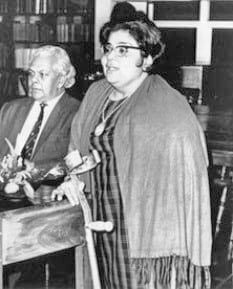July 3, 2019 issue
Authors' & Writers' Corner

Kamil Ali
The phone’s loud ring startled Juanita. Her first day as a death-scene cleaner made her nervous. She had started a single-owner housecleaning company, but competition drove her into the specialty line of business that her competitors found distasteful. The Coroner’s office had offered her a contract to clean residences after they had completed processing scenes of death.
Juanita took a deep breath and picked up the phone on the fourth ring. She cleared her

After collecting the apartment key from the Management office, she rode the elevator to the eleventh floor and pulled her flat dolly on wheels to her intended destination. She listened for a moment and inhaled the stale air in the corridor before she inserted the key into the lock and turned it.
She shivered and blacked out for a moment when a blast of cold putrid air rushed through her into the apartment when she opened the door. She stumbled but recovered in time to grab the door jamb to steady herself and gaze into the apartment. The Coroner’s staff had removed everything, leaving the apartment empty for her to clean in preparation for the next tenant.
When she took a step in, every hair on her body stood on end. The musty smell of lingering death made her queasy. She pulled out a scented surgical mask and covered her nose and mouth with it. She used latex gloves to clamp the long sleeves of her white cotton cleaning gown and slipped knee-high rubber boots over her blue jeans.
Afraid to lock herself in the apartment, she placed her dolly between the door and the jamb to keep it open while she explored the surroundings.
An antique camera on a tripod in a corner of the bedroom caught her attention. Had the Coroner’s staff missed the photographic equipment? Curiosity made her press the shutter button. The camera clicked and rolled the film to the next frame. A piece of the film dangled from one corner of the camera. An examination of the negative showed the image of a boney old woman lying on her bed staring at the camera in a frown. Juanita spun around in fear of the woman behind her, but she stared at the bare carpeted floor where the bed had stood. She checked the angle from which the picture was taken. It matched the current position of the tripod. Her heart thumped with the mystery of how the camera captured a live scene of the past, complete with a time and date stamp.
Distracted by the supernormal event, Juanita abandoned her cleaning and moved the camera to a different angle on its tripod. She clicked the shutter release, and the camera pushed another negative out. This time it snapped the old woman on the bed glaring at someone or something outside of the camera’s angle at the foot of the bed. Juanita glanced at the spot but saw nothing. She aimed the camera at the old lady’s point of focus and snapped a picture. The negative showed a younger version of the old woman with a sneer on her face. She held the old woman’s toe in one hand and an empty syringe with a gray drop of liquid at the tip of the attached needle in the other. Juanita covered every inch of the bedroom using different angles of the camera until it ran out of film. She hurriedly cleaned the apartment and left with the camera and tripod hidden among her equipment.
Upon arrival at home, Juanita reexamined the dozens of time and date stamped negatives. They told the incredible story of the old woman’s last moments of life. The woman’s daughter had killed her with an injection of arsenic between her big and second toes, where a crease-line hid the puncture mark.
She showed the evidence to the Coroner, who exhumed the woman’s corpse and did a toxicology test on her body hairs. The daughter was arrested and confessed to living luxuriously on her mom’s life savings after the old woman had become paralyzed from a stroke. The daughter had assumed the role of power-of-attorney as the closest living relative. She had placed her mom in a government subsidized tenement building while she jet-setted around the world on the millions of dollars accumulated by her parents from their successful business ventures.
The daughter panicked when the mother’s therapy improved her motor skills enough to communicate with scrawled letters on paper. A piece of paper on the night table beside the bed accused her daughter of stealing her money. She threatened to expose her to the authorities, which precipitated her untimely death.
After the daughter’s conviction, Juanita received a letter from a lawyer’s office with a picture of her standing at the door of the apartment. The cloudy image of an older mustachioed gentleman with a hat and a cane passed through her. The tobacco pipe in his mouth reminded her of his putrid odor.
She researched the photograph and family name of the victim and found out that the old woman’s husband had made his fortune as a professional photographer. His widow had never parted with his beloved camera.

By Romeo Kaseram
Rajkumari Singh was born on October 13, 1923, in Georgetown, in what was then British Guiana. Her father, Dr Jung Bahadur Singh, was born at Goed Fortuin, West Bank Demerara, while her mother, Alice Bhagwandai Singh (neé Persad), was born in Suriname.
Singh contracted polio when she was six years old. As a young girl, her early years are backgrounded in a household populated with a lineage of mainstream achievers, and thriving with activism. Vibert C. Cambridge, writing in Celebrating our Creative Personalities, published in Stabroek News in 2004, tells us Singh’s great grandfather was a Kshatriya from Bengal. According to Wikipedia, a Kshatriya is the second tier of the four varnas, or social orders, of Hindu society, and is associated with warriorhood. Cambridge tells us Singh’s great grandfather came to the Caribbean as a Christian interpreter, and served in Grenada, British Guiana, and finally in Suriname as Chief Interpreter of Indian Languages.
Cambridge adds Singh’s parents met while travelling on a ship that had transported indentured immigrants from India to the Caribbean. They were married on February 23, 1912, with the wedding performed as a civil ceremony, and under Hindu and Christian rites. Singh’s mother flourished in the performing arts. In 1929, after successfully producing the play Savitri, her mother founded the British Guiana Dramatic Society. It thrived for almost two decades as the “cradle of Indian culture”, Cambridge notes.
Singh’s mother was also actively engaged in social welfare projects as a member of the Red Cross, the Young Women’s Christian Association, and the Dharm Shala. In 1936, her mother founded the Balak Sahaita Mandalee, a child welfare organisation for needy Indo-Caribbean children. Singh’s mother was the recipient of an MBE award.
Her father also contributed significantly to Singh’s formative, early life with his overlapping professional, cultural, and political work. He graduated from medical studies at Edinburgh University in 1919, and practised medicine on the ships taking indentured immigrants to the Caribbean, and then back to India at the end of indentureship contracts. By 1920 he was the medical superintendent on the SS Madian, and in 1938, was the surgeon superintendent on the SS Ganges. His sea travels took him to Fiji, Natal, Jamaica, Suriname, and Trinidad.
Singh’s parents were also involved in political activities, Cambridge tells us. Between 1920 and 1949, her father served six times as President of the British Guiana East Indian Association. In 1929 he became a member of the Legislature for Demerara-Essequibo, serving on many committees and boards during his legislative tenure. Her father also founded the Maha Sabha, and was its president from 1935 to 1955. He was awarded the CBE in 1944.
Such a milieu of social, professional, and political parental achievement during her formative years provided ample, nurturing ground for Singh to emulate and flourish. It was an environment that later led to her establishing “a reputation as an innovative and multi-talented broadcaster, producer, director, playwright, poet, songwriter and cultural activist”, Cambridge writes. Singh went on to become an announcer and presenter of Indian cultural programmes on Radio Demerara, was a member of the British Guiana Dramatic Society, and produced the play Gitanjali.
Following the political path shaped by her father, during the 1960s Singh worked with the People’s Progressive Party, and served on the Commission of Inquiry into the racial violence at Wismar. She was also the editor of the literary booklet, Heritage, and a mentor for emerging writers in the post-independence era as Mahadai Das and Rooplal Monar. Singh published six short stories in 1960, A Garland of Stories. In 1972, she joined the Guyana National Service, a move not favourably viewed in some quarters of the Indo-Guyanese community.
The body of Singh’s literary work is well-respected for its emphasis on her Indo-Caribbean roots. In his paper, “‘You Want to be a Coolie Woman?’: Gender and Ethnic Identity in Indo-Caribbean Women’s Writing, Jeremy Poynting notes in the text Caribbean Women Writers: Essays from the First International Conference its prominence in her works, and with other writers as Das and Parvati Persaud Edwards.
Poynting notes Singh’s writings from the late 1940s to the mid-1970s contain a pioneering articulation of an Indo-Caribbean woman’s perspective. He describes her as “a person of great fortitude”, who while a mother of eight, still “led an active political life, was surrogate artistic mother to many younger writers, and still managed to write an unpublished novel, several plays, and a collection of short stories and uncollected poems and stories…”
Among Singh’s best work, Poynting adds, is the collection of poems, Days of the Sahib Are Over (1971), which “speaks clearly and resolutely of her commitment to restore the invisible Indo-Caribbean woman to the stage of history”. Poynting also notes Singh being “intensely proud of her Indo-Guyanese heritage”, and “a fierce critic of Indian racial chauvinism and gender oppression”. One of her plays, The Sound of Her Bells (1974), Poynting writes, “is an attack on caste intolerance and male chauvinism in the guise of brahminical Hindu piety”.
Also, in the poem, No More Kitchree for the Groom, Poynting notes Singh’s commentary on marriage customs, with Wikipedia pointing to how it sheds “light on the shared responsibility of families and communities for the well-being of daughters, and the abuse of the Hindu tradition of dowry”. In summing up Singh’s contribution to the emergent Indo-Caribbean discourse, Poynting tells us: “What is important about Singh’s position was that she mounted her attack on the male-centeredness of Indian culture from within Indian culture itself.”
Wikipedia notes how Singh’s work, such as the poem, Per Ajie, “epitomises the journey of Indians to the Caribbean, through the eyes of an Indo-Caribbean visualising her paternal great-grandmother making the voyage on one of the historic migratory ships headed for Guyana.” Written in a Shakespearean style, Wikipedia notes how the technique elevates “the topic of Indian indentureship into circles of serious literary critique”. In another poem, I See Bent Figures, Wikipedia adds how Singh “describes the struggles and achievements of indentured Indians laboring on plantations in the Caribbean”.
For her contribution to Guyanese cultural life, Singh was among the first recipients (posthumously) of the Wordsworth McAndrew Award in 2002; she also received the prestigious Guyana’s Arrow of Achievement in 1970; she passed away at the age of 56 in 1979.
(Sources for this exploration: Stabroek News; Caribbean Women Writers: Essays from the First International Conference; and Wikipedia.)